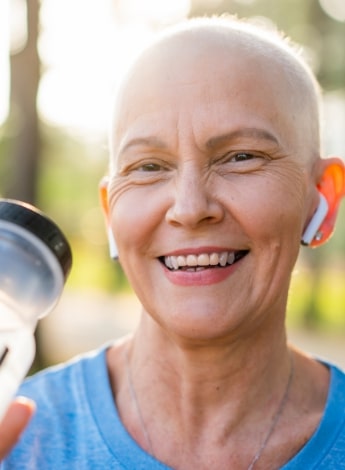
Physiotherapy and exercise rehabilitation in cancer care

Dr Amy Dennett, Jayne Grubits, Tara Redemski, Amy Bowman, Hildegard Reul-Hirche and Germaine Tan from the APA Cancer, Palliative Care and Lymphoedema national group present five discussion points about exercise prescription in cancer treatment and the role of physiotherapists.
1. Exercise is safe and beneficial before, during and after cancer treatment

Regular exercise can help mitigate the effects of cancer treatment, including fatigue.
Professional peak bodies recommend that exercise be embedded into cancer care (Cormie et al 2018).
Physiotherapists play a key role in providing safe, individualised exercise prescription before, during and after cancer treatment.
Exercise reduces cancer-related fatigue and can help mitigate other treatment effects.
Exercise also helps improve quality of life and physical function.
To achieve these benefits, it is recommended that people with cancer complete moderate-intensity aerobic exercise for 30 minutes three times per week and include strength training at least twice per week (Campbell et al 2019).
Regular exercise up to 150 minutes per week may have further protective effects of preventing cancer recurrence and reducing mortality (Patel et al 2019).
Many physiotherapists lack confidence in prescribing exercise to people with cancer (Dennett et al 2021).
To ensure that people with cancer receive safe and appropriate programs, exercise should be individually tailored based on their needs, in accordance with exercise principles such as specificity, progression, overload and FITT (frequency, intensity, time, type).
Validated outcome measures (eg, the six-minute walk test) and physiological measures (eg, heart rate) should be used to set and monitor exercise prescription.
Resources such as the Cancer Exercise Toolkit are now available to help physiotherapists access evidence-based content to prescribe safe and appropriate cancer exercise programs (Dennett et al n.d.).
2. High-impact exercise can improve the bone health of cancer survivors
Chemotherapy and endocrine therapies are crucial for improving breast cancer survival but are associated with accelerated bone mineral density loss and increased risk of fracture.
To increase bone mineral density, high-impact and resistance exercise is recommended for people with osteoporosis (The Royal Australian College of General Practitioners and Osteoporosis Australia 2017).
High-impact exercise includes activities such as bounding, skipping, squat jumps and leaping.
These guidelines may benefit cancer survivors, particularly those with hormone-sensitive cancers like breast and prostate given their high risk for osteoporosis.
A recent review found that compared to usual care, exercise has significant effects for preserving whole body and particularly hipbone density (Singh & Toohey 2022).
For maximal benefit of exercise to improve bone mineral density, interventions should be longer than six months’ duration with strategies in place to maintain exercise adherence.
Precautions to be considered when prescribing high-impact exercises include falls risk, chemotherapy-induced peripheral neuropathy, cognition and pre-existing fractures or bone metastases.
Modifications may be required.
People with cancer who cannot participate in high-impact exercise should still be encouraged to exercise to improve strength and balance, which may in turn prevent falls and subsequent fractures.
3. Exercise is safe for people with bone metastases

With formal monitoring, exercise is safe and beneficial for people with bone metastases.
Exercise is safe for people with bone metastases (Weller et al 2021).
Traditionally, exercise has been underused in this population because of concerns over skeletal complications (Campbell et al 2022).
Participating in structured and supervised exercise improves physical function, muscle strength and health-related quality of life for people with cancer-related bone metastases (Campbell et al 2022).
The perceived risk of skeletal complications should be weighed against the potential health benefits of exercise (Campbell et al 2022).
To ensure patient safety, physiotherapists should perform a risk assessment and consult with the medical team throughout assessment and exercise training.
Exercise prescription should follow the standard exercise recommendations as outlined by the International Multidisciplinary Roundtable’s Exercise Guidelines for Cancer Survivors, with consideration given to the location and presentation of the bone metastases.
Formal monitoring and exercise prescription adjustment should be ongoing (Campbell et al 2022).
Ensuring good alignment, with emphasis on controlled movement and technique, will limit the risk of adverse events.
4. High-intensity interval training can be prescribed safely in cancer survivors
High-intensity interval training (HIIT) is safe, tolerable and effective when accompanied by a thorough assessment and individualised prescription (Klika & Stafford 2021).
Characterised by short, repeated bouts of high-intensity exercise with short rest periods of little to no exertion, HIIT is recommended as a time-efficient mode of exercise that allows patients to increase exercise intensity.
HIIT is particularly beneficial for improving cardiovascular fitness, muscle mass and functional capacity.
Higher intensities of exercise have been linked to higher glycolytic metabolism and the stimulation of immune cell pathways associated with improved cancer outcomes (Lavín-Pérez et al 2021).
HIIT is most beneficial when initiated before commencing anti-cancer treatment, but may also provide smaller benefits when initiated during and after treatment.
Optimal exercise prescription parameters for HIIT for people with cancer are unknown.
General recommendations for HIIT from the American College of Sports Medicine suggest completing HIIT twice weekly with a minimum of 48 hours between sessions, at an intensity of 80–100 per cent peak heart rate or 60–90 per cent of peak oxygen uptake.
Session times should last between 30 and 60 minutes with two to four minutes of vigorous exercise and approximately three minutes of rest between intervals and sets.
Examples of HIIT that physiotherapists could prescribe include stationary cycling, incline treadmill walking and jogging or running (Klika & Stafford 2021).
5. Exercise is a key part of lymphoedema prevention and management
Cancer-related lymphoedema is a consequence of a damaged lymphatic system and of disrupting normal lymph flow as a result of cancer or cancer treatment.

Exercise helps to prevent and manage lymphoedema caused by cancer or cancer treatment.
This causes the accumulation of protein-rich fluid in the interstitial tissue, which leads to swelling of the body part (Ridner 2002).
Physiotherapists are in a position to promote, guide and encourage participation in exercise to prevent and manage lymphoedema.
They can also provide reassurance in relation to patient fears of developing lymphoedema or exacerbating existing swelling through vigorous exercise (Lee et al 2009).
Any type, intensity, mode, supervised or unsupervised form of exercise may be beneficial for reducing lymphoedema risk and exercise may be particularly helpful for people who have undergone extensive lymph node dissection.
Wearing compression garments during exercise may also be considered.
However, recent evidence involving women with breast cancer-related lymphoedema could neither support nor refute the benefits of compression.
Therefore, wearing a garment during exercise requires an individual approach and, as with exercise prescription, adjustments should be guided by symptoms (Hayes et al 2020).
Head to australian.physio/translation for an infographic poster version of this article.
>> Dr Amy Dennett APAM is an APA Cancer Physiotherapist and a Victorian Cancer Agency Fellow at Eastern Health, Victoria. Her research focuses on cancer and exercise.
>> Tara Redemski MACP is an APA Cancer Physiotherapist, an APA Lymphoedema Physiotherapist and a senior physiotherapist at the Gold Coast University Hospital’s Cancer and Blood Disorders Unit.
>> Jayne Grubits APAM is a physiotherapist at ELPE Health, where she has a focus on disability and cancer rehabilitation with the aim of improving physical function and quality of life.
>> Amy Bowman APAM is a senior physiotherapist and lymphoedema therapist at the Peter MacCallum Cancer Centre in Melbourne.
>> Hildegard Reul-Hirche MACP is an APA Lymphoedema Physiotherapist and an honorary research physiotherapist at the Royal Brisbane and Women’s Hospital.
>> Germaine Tan APAM is a physiotherapist involved in cancer exercise clinical and research work at Eastern Health, Victoria and the national chair of the APA Cancer, Palliative Care and Lymphoedema national group.
- References
-
1. Cormie et al 2018 MJA 4: 184–187
2. Campbell et al 2019 Med Sci Sports Exerc 51: 2375–2390
3. Patel et al 2019 Med Sci Sports Exerc 51:2391–2402
4. Dennett et al 2021 Physiotherapy 113:1–7
5. Dennett et al n.d. Cancer Exercise Toolkit, Trek Education, https://cancerexercisetoolkit.trekeducation.org/
6. The Royal Australian College of General Practitioners and Osteoporosis Australia. Osteoporosis prevention, diagnosis and management in postmenopausal women and men over 50 years of age. 2nd edn. East Melbourne, Vic: RACGP, 2017.
7. Singh, B. & Toohey, K. The effect of exercise for improving bone health in cancer survivors: A systematic review and meta-analysis. Journal of Science and Medicine in Sport. 2022; 25:31–40.
8. Weller, S., Hart, N., Bolam, K., Mansfield, S., Santa Mina, D., Winters-Stone, K., Campbell, A., Rosenberger, F., Wiskemann, J., Quist, M., Cormie, P., Goulart, J. and Campbell, K., 2021. Exercise for individuals with bone metastases: A systematic review. Critical Reviews in Oncology/Hematology, 166, p.103433.
9. Campbell, K., Cormie, P., Weller, S., Alibhai, S., Bolam, K., Campbell, A., Cheville, A., Dalzell, M., Hart, N., Higano, C., Lane, K., Mansfield, S., McNeely, M., Newton, R., Quist, M., Rauw, J., Rosenberger, F., Santa Mina, D., Schmitz, K., Winters-Stone, K., Wiskemann, J. and Goulart, J., 2022. Exercise Recommendation for People With Bone Metastases: Expert Consensus for Health Care Providers and Exercise Professionals. JCO Oncology Practice.
10. Klika, R. J., & Stafford, L. H. (2021). Exercise Oncology: High-Intensity Interval Training for Cancer Survivors. ACSM's Health & Fitness Journal, 25(5), 44–53.
11. Lavín-Pérez AM, Collado-Mateo D, Mayo X, Humphreys L, Liguori G, James Copeland R, Del Villar Álvarez F, Jiménez A. High-intensity exercise to improve cardiorespiratory fitness in cancer patients and survivors: A systematic review and meta-analysis. Scand J Med Sci Sports. 2021 Feb;31(2):265–294. doi: 10.1111/sms.13861. Epub 2020 Nov 5. PMID: 33098219.
12. Ridner, S.H., Breast cancer lymphedema: pathophysiology and risk reduction guidelines. Oncology Nursing Forum, 2002. 29(9): p. 1285–1293. doi: 10.1188/02.ONF.1285–1293.
13. Lee, T.S., et al., Factors that affect intention to avoid strenuous arm activity after breast cancer surgery. Oncology nursing forum, 2009. 36(4): p. 454–462. doi: 10.1188/09.ONF.454–462.
14. Hayes, S., et al., Do Women with Breast Cancer–related Lymphoedema Need to Wear Compression While Exercising?: Results from a Systematic Review and Meta-analysis. Current breast cancer reports, 2020. 12(3): p. 193–201. doi: 10.1007/s12609-020-00373-0. -
© Copyright 2025 by Australian Physiotherapy Association. All rights reserved.





